Professional Development Plan: Skills and Competencies Enhancement
VerifiedAdded on 2023/02/13
|21
|2263
|52
Homework Assignment
AI Summary
This assignment focuses on designing a professional development plan within a specific work context, addressing the enhancement of chosen skills and competencies. It begins with an exploration of proactive learning and evaluation, drawing on Mogill's principles for success. The assignment delves into the importance of being solution-focused, accountable, and using SMART goals. It also covers the significance of making your own luck, consistency, and surrounding yourself with the right people. The assignment further discusses the value of honesty and seeking guidance, referencing Gross and Grant. It then introduces the concept of initiative in developmental processes, as defined by MindTools, and the importance of recorded learning through development records. The core of the assignment involves applying learning and development theories, including behaviorism, cognitivism, and constructivism, alongside instructional design models like ADDIE. A blank template for a personal development plan is provided, guiding students through defining career goals, identifying skills gaps, and creating action plans, including obstacles, solutions, and evaluation criteria. The assignment concludes with a discussion of relevant references and resources for further study.

Unit-3
Professional
Identity
and Practice
Lecturer-Soshanya Pike
Week 8
LO3. Design a professional
development plan, within a specific
work context
Professional
Identity
and Practice
Lecturer-Soshanya Pike
Week 8
LO3. Design a professional
development plan, within a specific
work context
Paraphrase This Document
Need a fresh take? Get an instant paraphrase of this document with our AI Paraphraser
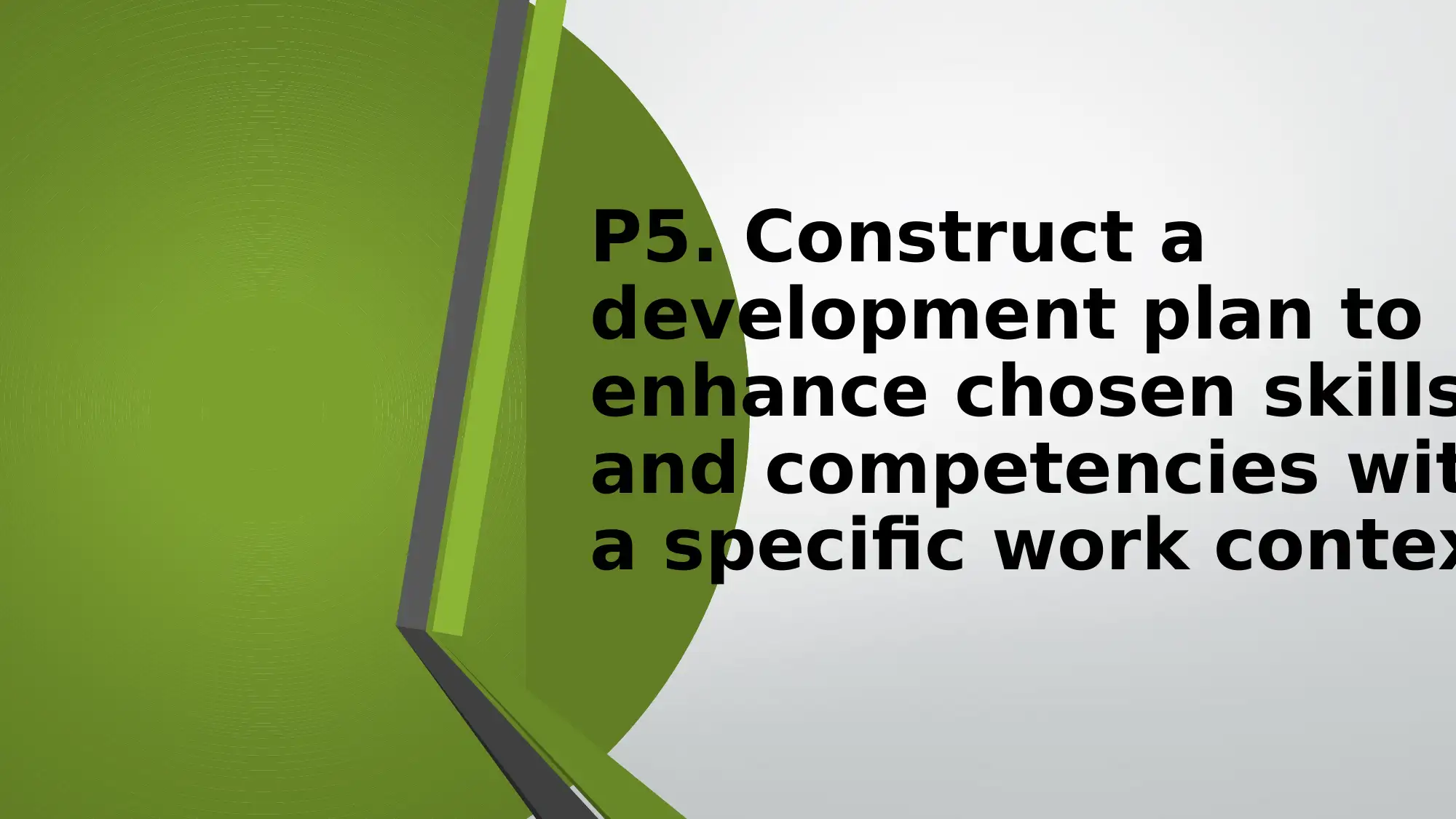
P5. Construct a
development plan to
enhance chosen skills
and competencies wit
a specific work contex
development plan to
enhance chosen skills
and competencies wit
a specific work contex

•Proactive learning and evaluation
• According to Mogill (2014), being proactive in your own becoming is
of hustle and problem-solving. He list eight key points that he believ
create a clear path to success.
• 1. It’s all about you- Take ownership of your problems, nobody el
going to solve, it is up to you. Family and friends are a support system
They cannot succeed for you. Only you can do that.
• 2. Be solution-focused-Good problem-solving skills is one of the g
traits of effective people. Everyone will run into problems, how you
them that makes you effective. The most effective way to handle a
problem is to focus on finding a solution. Focus on what you can con
with the final outcome. If you lead by example, your team will learn
approach problems and solutions effectively.
• According to Mogill (2014), being proactive in your own becoming is
of hustle and problem-solving. He list eight key points that he believ
create a clear path to success.
• 1. It’s all about you- Take ownership of your problems, nobody el
going to solve, it is up to you. Family and friends are a support system
They cannot succeed for you. Only you can do that.
• 2. Be solution-focused-Good problem-solving skills is one of the g
traits of effective people. Everyone will run into problems, how you
them that makes you effective. The most effective way to handle a
problem is to focus on finding a solution. Focus on what you can con
with the final outcome. If you lead by example, your team will learn
approach problems and solutions effectively.
⊘ This is a preview!⊘
Do you want full access?
Subscribe today to unlock all pages.

Trusted by 1+ million students worldwide
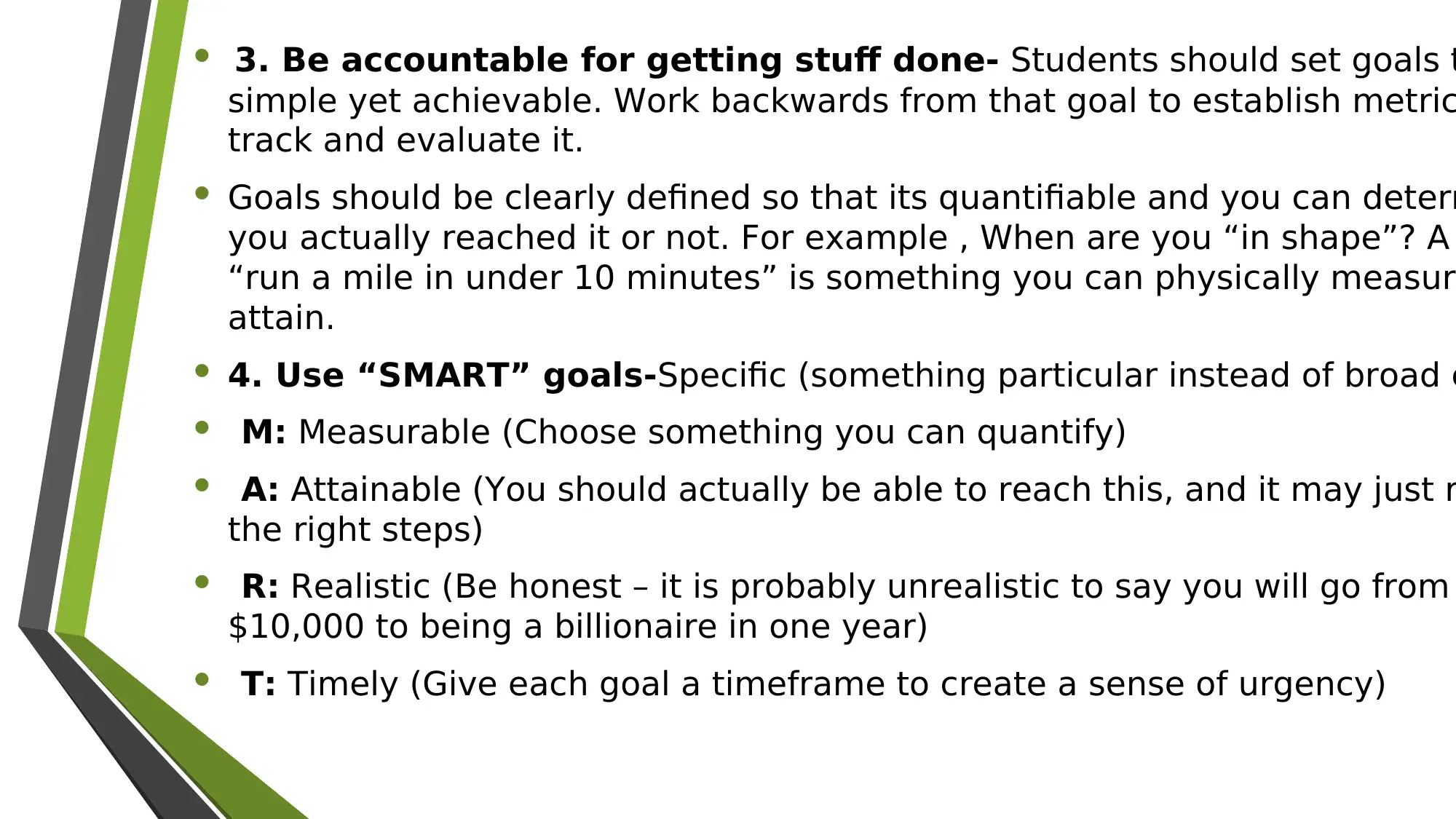
• 3. Be accountable for getting stuff done- Students should set goals t
simple yet achievable. Work backwards from that goal to establish metric
track and evaluate it.
• Goals should be clearly defined so that its quantifiable and you can determ
you actually reached it or not. For example , When are you “in shape”? A
“run a mile in under 10 minutes” is something you can physically measure
attain.
• 4. Use “SMART” goals-Specific (something particular instead of broad c
• M: Measurable (Choose something you can quantify)
• A: Attainable (You should actually be able to reach this, and it may just r
the right steps)
• R: Realistic (Be honest – it is probably unrealistic to say you will go from
$10,000 to being a billionaire in one year)
• T: Timely (Give each goal a timeframe to create a sense of urgency)
simple yet achievable. Work backwards from that goal to establish metric
track and evaluate it.
• Goals should be clearly defined so that its quantifiable and you can determ
you actually reached it or not. For example , When are you “in shape”? A
“run a mile in under 10 minutes” is something you can physically measure
attain.
• 4. Use “SMART” goals-Specific (something particular instead of broad c
• M: Measurable (Choose something you can quantify)
• A: Attainable (You should actually be able to reach this, and it may just r
the right steps)
• R: Realistic (Be honest – it is probably unrealistic to say you will go from
$10,000 to being a billionaire in one year)
• T: Timely (Give each goal a timeframe to create a sense of urgency)
Paraphrase This Document
Need a fresh take? Get an instant paraphrase of this document with our AI Paraphraser
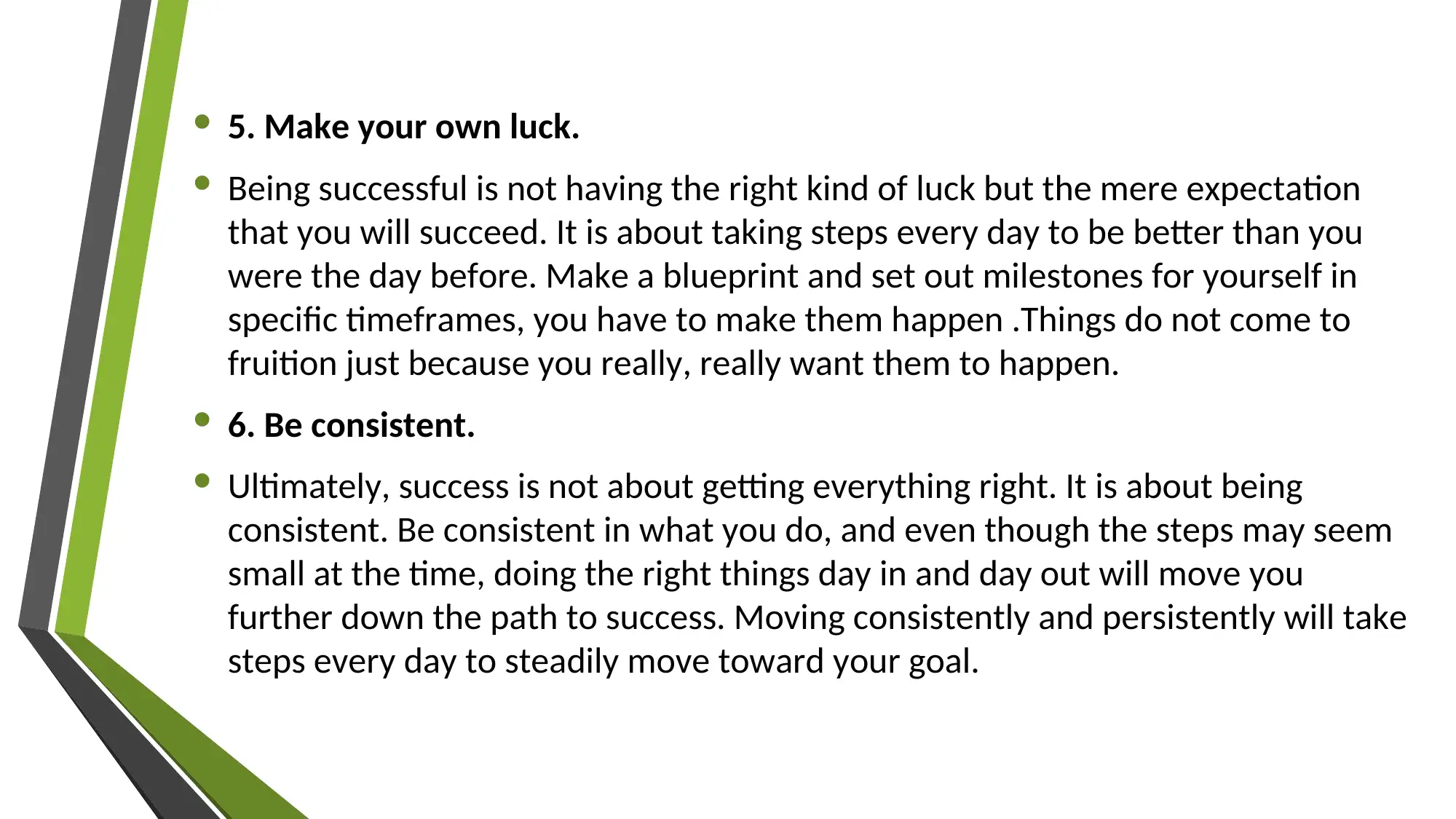
• 5. Make your own luck.
• Being successful is not having the right kind of luck but the mere expectation
that you will succeed. It is about taking steps every day to be better than you
were the day before. Make a blueprint and set out milestones for yourself in
specific timeframes, you have to make them happen .Things do not come to
fruition just because you really, really want them to happen.
• 6. Be consistent.
• Ultimately, success is not about getting everything right. It is about being
consistent. Be consistent in what you do, and even though the steps may seem
small at the time, doing the right things day in and day out will move you
further down the path to success. Moving consistently and persistently will take
steps every day to steadily move toward your goal.
• Being successful is not having the right kind of luck but the mere expectation
that you will succeed. It is about taking steps every day to be better than you
were the day before. Make a blueprint and set out milestones for yourself in
specific timeframes, you have to make them happen .Things do not come to
fruition just because you really, really want them to happen.
• 6. Be consistent.
• Ultimately, success is not about getting everything right. It is about being
consistent. Be consistent in what you do, and even though the steps may seem
small at the time, doing the right things day in and day out will move you
further down the path to success. Moving consistently and persistently will take
steps every day to steadily move toward your goal.
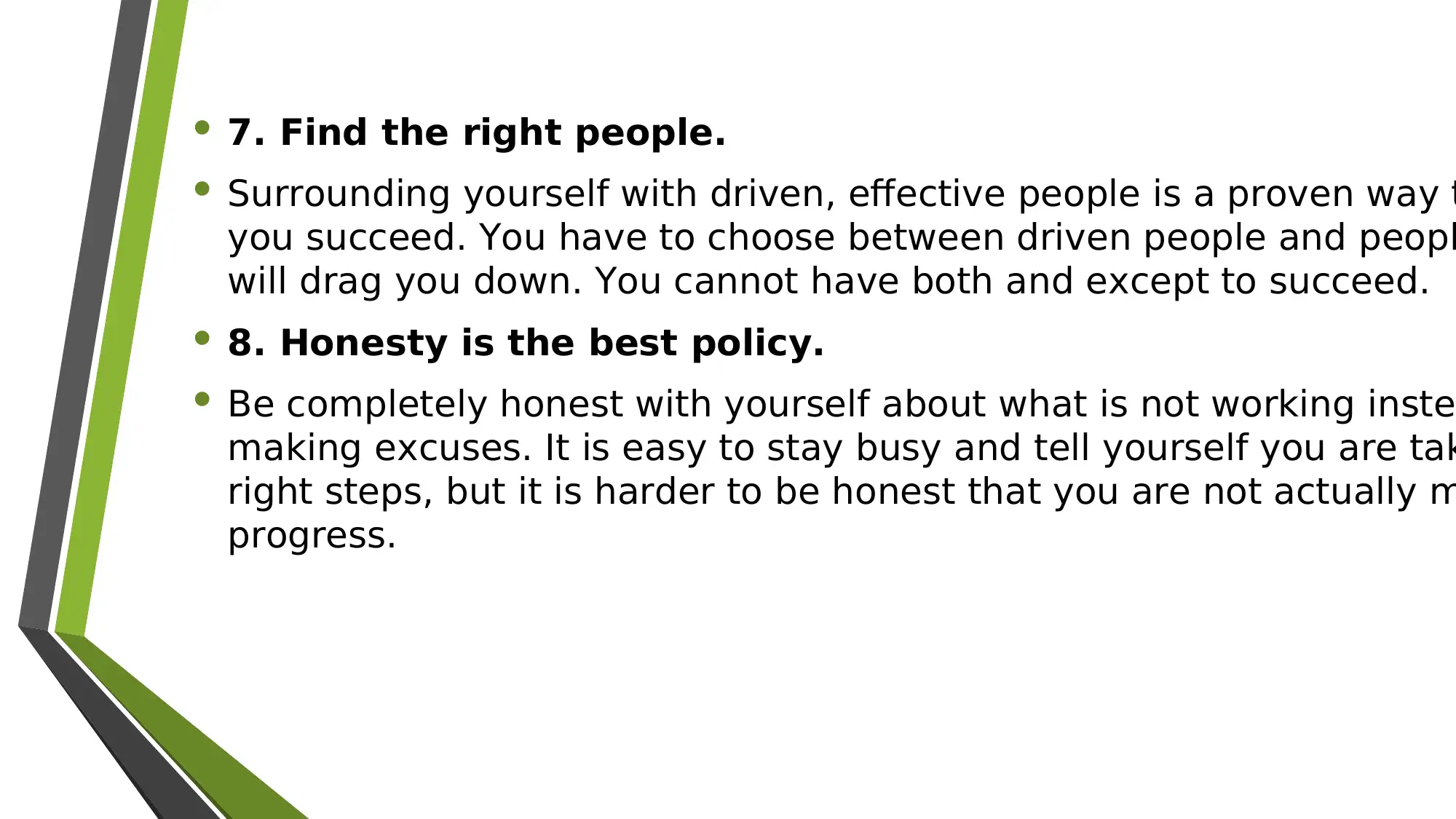
• 7. Find the right people.
• Surrounding yourself with driven, effective people is a proven way t
you succeed. You have to choose between driven people and peopl
will drag you down. You cannot have both and except to succeed.
• 8. Honesty is the best policy.
• Be completely honest with yourself about what is not working inste
making excuses. It is easy to stay busy and tell yourself you are tak
right steps, but it is harder to be honest that you are not actually m
progress.
• Surrounding yourself with driven, effective people is a proven way t
you succeed. You have to choose between driven people and peopl
will drag you down. You cannot have both and except to succeed.
• 8. Honesty is the best policy.
• Be completely honest with yourself about what is not working inste
making excuses. It is easy to stay busy and tell yourself you are tak
right steps, but it is harder to be honest that you are not actually m
progress.
⊘ This is a preview!⊘
Do you want full access?
Subscribe today to unlock all pages.

Trusted by 1+ million students worldwide

Requesting advice/guidance
Gross (2016) shared that people who use their strengths every day
times more likely to be engaged on the job. She added that this lea
a positive impact on performance, productivity, and profitability.
She went further to explains that knowledge of your strengths and
weaknesses can serve as a guide for when to ask for help. “By bein
aware and knowing your own strengths, you can more easily turn to
people to get things done that aren’t your natural strengths”. (Gros
2016)
In the workplace it can feel particularly uncomfortable to make such
requests especially where we’re typically keen to demonstrate as m
expertise, competence, and confidence. However, as Grant (2018) s
it’s virtually impossible to advance in modern organizations without
assistance from others.
Gross (2016) shared that people who use their strengths every day
times more likely to be engaged on the job. She added that this lea
a positive impact on performance, productivity, and profitability.
She went further to explains that knowledge of your strengths and
weaknesses can serve as a guide for when to ask for help. “By bein
aware and knowing your own strengths, you can more easily turn to
people to get things done that aren’t your natural strengths”. (Gros
2016)
In the workplace it can feel particularly uncomfortable to make such
requests especially where we’re typically keen to demonstrate as m
expertise, competence, and confidence. However, as Grant (2018) s
it’s virtually impossible to advance in modern organizations without
assistance from others.
Paraphrase This Document
Need a fresh take? Get an instant paraphrase of this document with our AI Paraphraser
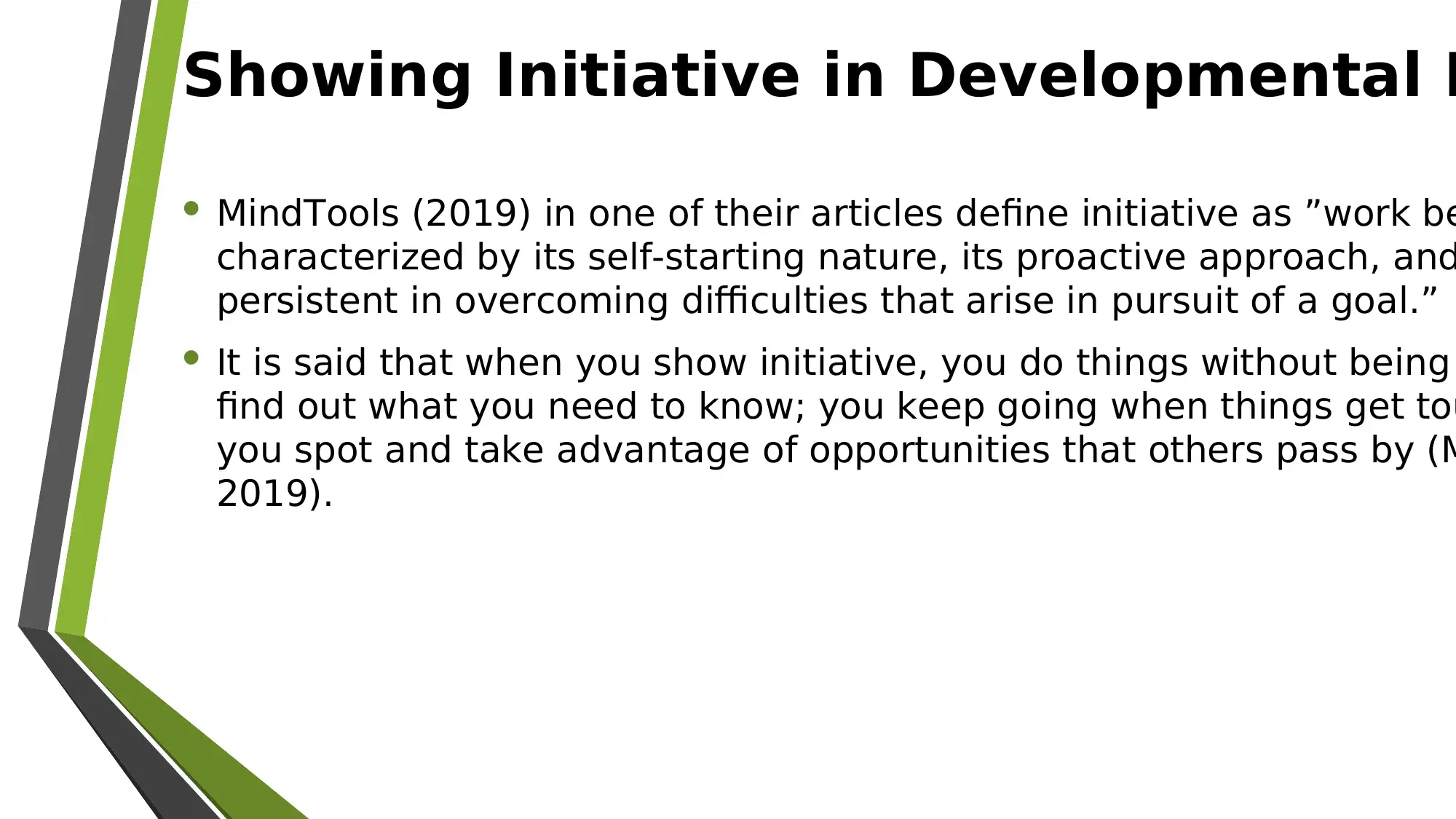
Showing Initiative in Developmental P
• MindTools (2019) in one of their articles define initiative as ”work be
characterized by its self-starting nature, its proactive approach, and
persistent in overcoming difficulties that arise in pursuit of a goal.”
• It is said that when you show initiative, you do things without being
find out what you need to know; you keep going when things get tou
you spot and take advantage of opportunities that others pass by (M
2019).
• MindTools (2019) in one of their articles define initiative as ”work be
characterized by its self-starting nature, its proactive approach, and
persistent in overcoming difficulties that arise in pursuit of a goal.”
• It is said that when you show initiative, you do things without being
find out what you need to know; you keep going when things get tou
you spot and take advantage of opportunities that others pass by (M
2019).
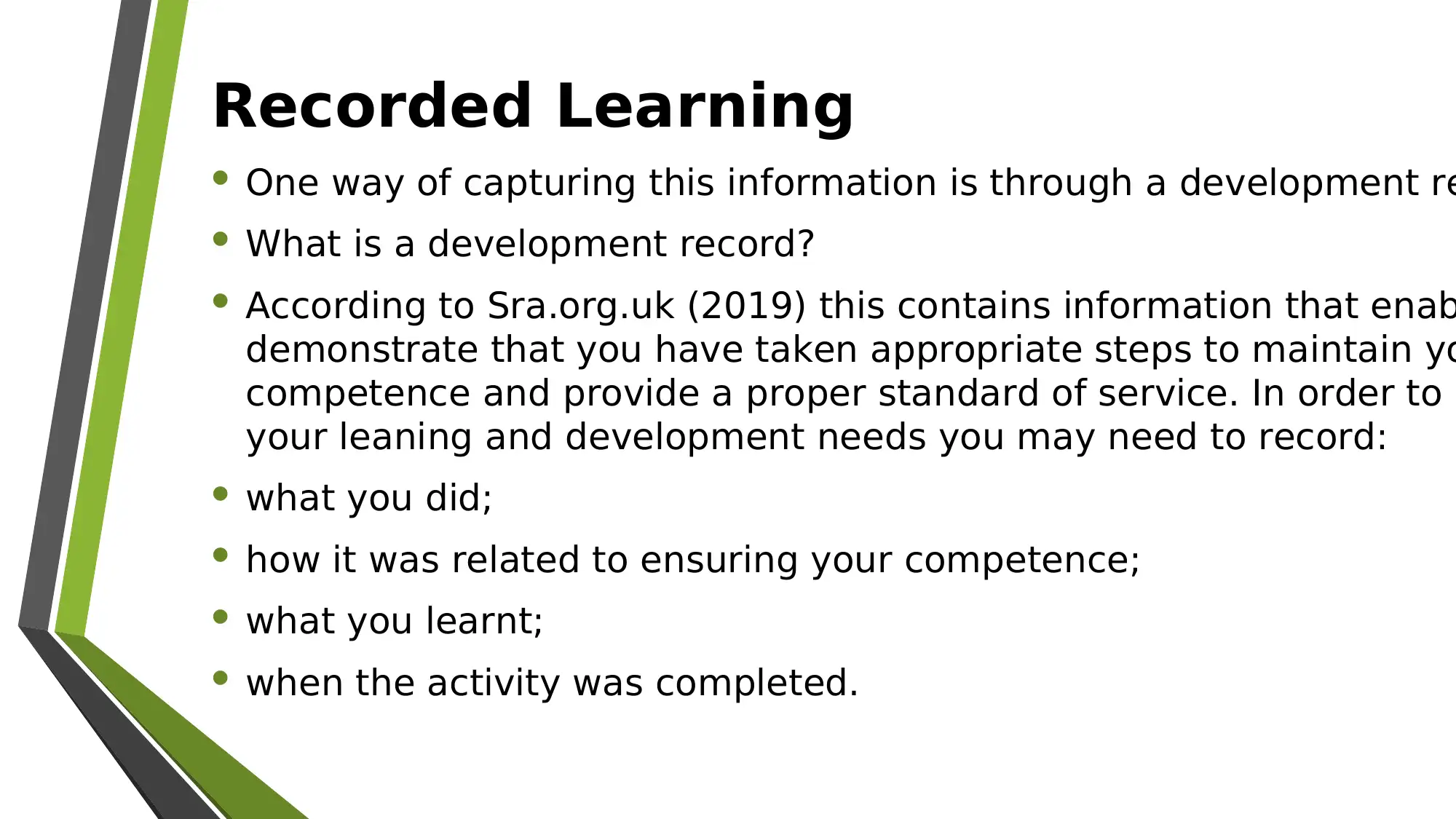
Recorded Learning
• One way of capturing this information is through a development re
• What is a development record?
• According to Sra.org.uk (2019) this contains information that enab
demonstrate that you have taken appropriate steps to maintain yo
competence and provide a proper standard of service. In order to i
your leaning and development needs you may need to record:
• what you did;
• how it was related to ensuring your competence;
• what you learnt;
• when the activity was completed.
• One way of capturing this information is through a development re
• What is a development record?
• According to Sra.org.uk (2019) this contains information that enab
demonstrate that you have taken appropriate steps to maintain yo
competence and provide a proper standard of service. In order to i
your leaning and development needs you may need to record:
• what you did;
• how it was related to ensuring your competence;
• what you learnt;
• when the activity was completed.
⊘ This is a preview!⊘
Do you want full access?
Subscribe today to unlock all pages.

Trusted by 1+ million students worldwide

In summarizing;
• Record the activity you have undertaken to address your learning a
development needs (Sra.org.uk,2019)
• Evaluating your learning and development activity will help you ide
key points you can introduce into your practice or where further le
development is required (Sra.org.uk,2019)
• It is important to record your activity and evaluation in order to dem
that you are addressing your learning and development needs
(Sra.org.uk,2019)
• Record the activity you have undertaken to address your learning a
development needs (Sra.org.uk,2019)
• Evaluating your learning and development activity will help you ide
key points you can introduce into your practice or where further le
development is required (Sra.org.uk,2019)
• It is important to record your activity and evaluation in order to dem
that you are addressing your learning and development needs
(Sra.org.uk,2019)
Paraphrase This Document
Need a fresh take? Get an instant paraphrase of this document with our AI Paraphraser

M3 Provide a detailed development
that applies underpinning learning an
development theory, in a specific wor
context
that applies underpinning learning an
development theory, in a specific wor
context

Learning and Development Theories
Table:1 The three primary learning theories
Applying learning theories and instructional design models for effective instruction (Khalil and Elkhider, 2016, p. 2)
Table 1. The three primary learning theories
Behaviorism Cognitivism Constructivism
Definition of
learning Learning is the acquisition of new behavior
Learning involves the acquisition and
reorganization of cognitive structures Learning is search for meaning
Learner's role Passive participants in the learning processActive participants in the learning processActive participants in the learning process
Main strategy Facilitates knowing what Facilitates knowing how Reflection in action
Implication
•Objective-based instruction
•Competency-based education
•Skill development and training
•Concept maps
•Reflective thinking
•Authentic case-based learning environment
•Reflective practice
•Collaborative construction of knowledge
Example of
teaching method
•Lecture
•Simulation
•Demonstration
•Programmed instruction
•Problem solving
•Concept mapping
•Advanced organizer
•Diaries/reflection
•Role modeling
•Problem-based learning
•Collaborative learning
Assessment
strategies
Criterion-referenced assessment: multiple-
choice questions and recall items Essays, written reports, and projects Elimination of grades and standardized
testing; peer grading/review
Table:1 The three primary learning theories
Applying learning theories and instructional design models for effective instruction (Khalil and Elkhider, 2016, p. 2)
Table 1. The three primary learning theories
Behaviorism Cognitivism Constructivism
Definition of
learning Learning is the acquisition of new behavior
Learning involves the acquisition and
reorganization of cognitive structures Learning is search for meaning
Learner's role Passive participants in the learning processActive participants in the learning processActive participants in the learning process
Main strategy Facilitates knowing what Facilitates knowing how Reflection in action
Implication
•Objective-based instruction
•Competency-based education
•Skill development and training
•Concept maps
•Reflective thinking
•Authentic case-based learning environment
•Reflective practice
•Collaborative construction of knowledge
Example of
teaching method
•Lecture
•Simulation
•Demonstration
•Programmed instruction
•Problem solving
•Concept mapping
•Advanced organizer
•Diaries/reflection
•Role modeling
•Problem-based learning
•Collaborative learning
Assessment
strategies
Criterion-referenced assessment: multiple-
choice questions and recall items Essays, written reports, and projects Elimination of grades and standardized
testing; peer grading/review
⊘ This is a preview!⊘
Do you want full access?
Subscribe today to unlock all pages.

Trusted by 1+ million students worldwide
1 out of 21
Related Documents
Your All-in-One AI-Powered Toolkit for Academic Success.
+13062052269
info@desklib.com
Available 24*7 on WhatsApp / Email
![[object Object]](/_next/static/media/star-bottom.7253800d.svg)
Unlock your academic potential
Copyright © 2020–2025 A2Z Services. All Rights Reserved. Developed and managed by ZUCOL.





